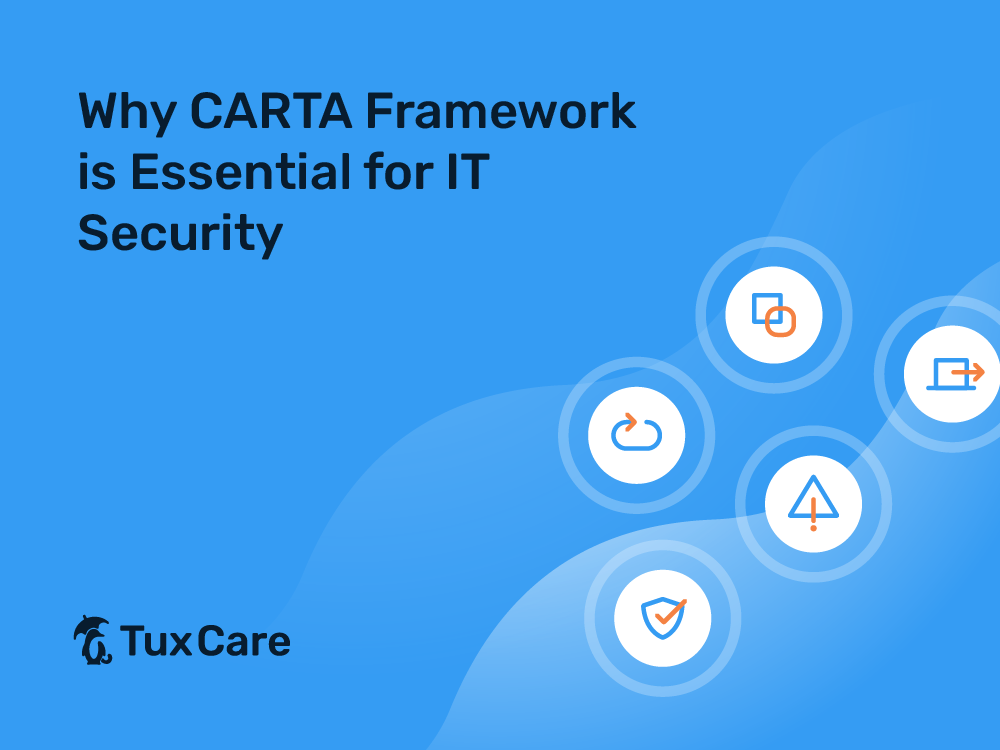Should Organizations Use the Gartner CARTA Framework in 2024?
- Organizations should shift from a traditional, static approach to cybersecurity to a more dynamic and risk-based approach.
- CARTA emphasizes the need for a dynamic security posture that adapts to evolving threats and a changing environment.
- Automated live patching can help organizations in adopting and implementing the Gartner CARTA framework more effectively.
As we move through 2024, the cybersecurity landscape continues to evolve, with threats becoming more sophisticated and persistent. Traditional security measures are proving to be insufficient, prompting organizations to consider more dynamic and adaptive approaches like the Gartner CARTA framework, also known as Continuous Adaptive Risk and Trust Assessment.
In this article, we’ll explore what the CARTA framework is, its importance in IT security, the challenges of implementing it, and how organizations can determine if it’s the right fit for them.
What is the Gartner CARTA Framework?
The Gartner CARTA framework is a comprehensive approach to cybersecurity that includes continuous and adaptive assessment of risks and trust levels. Unlike traditional security models that rely on static, point-in-time assessments, CARTA advocates for ongoing evaluation and real-time decision-making to respond to threats dynamically. This dynamic approach allows for a more secure and adaptable security posture.
Key components of CARTA include:
Continuous Monitoring: Instead of periodic checks, CARTA involves continuous monitoring of the IT environment, identifying and responding to threats as they happen.
Adaptive Response: Security measures are adjusted in real time based on the evolving threat landscape, ensuring that defenses are always aligned with current risks.
Risk and Trust Assessment: CARTA moves beyond the binary “allow or deny” approach of traditional methods. By continuously evaluating the trustworthiness of users, devices, and applications, CARTA helps organizations make informed decisions about access and permissions.
Integration with Business Processes: Security is integrated into business workflows, ensuring that risk management supports organizational goals without hindering productivity.
Why the CARTA Framework Is Essential for IT Security
The CARTA model is often considered vital for modern IT security because its real-time threat mitigation through continuous monitoring enables organizations to promptly detect and respond to threats, minimizing potential impacts. This immediate response enhances resilience against cyber threats.
CARTA also improves organizational agility by adapting security measures in real time to counteract swiftly emerging threats, maintaining effective defenses. Moreover, it enhances decision-making with continuous risk and trust assessments, reducing false positives and negatives for more efficient security operations.
Additionally, CARTA aligns security strategies with business goals, ensuring that protective measures enhance rather than obstruct business operations. This integration of security into the business framework supports both protection and productivity.
Common Challenges in Integrating Gartner CARTA
Integrating CARTA with existing security infrastructure can be complex and require careful planning. Some reasons the CARTA model may pose a challenge to organizations is because it is seen to be:
Resource Intensive: The Gartner CARTA strategy demands continuous monitoring and automation, requiring substantial investment in technology and skilled staff.
Complexity: The dynamic nature of CARTA can add complexity to security operations, requiring advanced tools and expertise for effective management.
Data Overload: Continuous monitoring can generate vast amounts of data, making it challenging to identify relevant security signals within the influx.
Cultural Shift: Shifting from static controls to a dynamic approach requires a change in mindset for both IT security teams and end-users.
How Automated Live Patching Supports CARTA Implementation
Software vulnerabilities are one of the major reasons for cybersecurity risks, and timely patching is crucial to mitigate these risks. However, conventional patching methods often require system reboots or downtime, which can impact business continuity and productivity.
Live patching addresses this challenge by enabling organizations to apply security updates and patches to their systems without disrupting operations or requiring system reboots. This approach eliminates the need for scheduled downtime, helping organizations maintain a higher level of system availability and reduce the window of exposure to vulnerabilities. Additionally, automating the patching process ensures that systems are continuously updated with the latest security patches with minimal human intervention.
Automated live patching can significantly streamline the implementation and adoption of the Gartner CARTA framework. Here’s how:
Aligns with Continuous Monitoring: CARTA’s emphasis on continuous monitoring and adaptive response is well-supported by automated live patching. Continuous monitoring can identify vulnerabilities in real time, and automated patching can immediately address these vulnerabilities, ensuring the system is always protected against known threats.
Real-Time Adaptive Response: Automated live patching allows for immediate response to newly discovered vulnerabilities. This real-time adaptability is a core principle of CARTA, enabling organizations to dynamically adjust their security measures in response to emerging threats.
Reduces Downtime: Automated live patching eliminates the need for system reboots or scheduled maintenance windows, ensuring that security updates do not interrupt business operations. This is crucial for maintaining the balance between robust security and operational efficiency that CARTA advocates.
Frees Up IT Resources: By automating the patching process, IT teams can focus on more strategic tasks, such as threat analysis and response, rather than manual patch management. This resource optimization supports the continuous and adaptive nature of CARTA.
Improved Trust Assessment: Automated patching ensures all systems are updated and on the same security level. This consistency is crucial for accurate trust assessments, as outdated or unpatched systems introduce unknown vulnerabilities. Automation minimizes human error in patching, guaranteeing patches are applied correctly and consistently across the entire IT environment. This reliability strengthens CARTA’s goal of maintaining high levels of trust within the network.
TuxCare offers automated live patching solutions, KernelCare Enterprise and LibCare, for Linux systems, delivering security patches to the Linux kernel and critical libraries like glibc and OpenSSL without requiring reboots. This not only minimizes downtime but also aligns perfectly with the principles of the Gartner CARTA approach. By implementing TuxCare’s live patching, organizations following the CARTA model can ensure their systems remain protected against current and evolving threats, all while supporting uninterrupted business operations.
TuxCare also provides automated live patching services for Linux-based IoT environments and QEMU-based virtualization systems.
Is CARTA the Right Fit for Your Organization in 2024?
Before adopting the Gartner CARTA framework, organizations should consider the following factors to ensure it aligns with their needs and capabilities:
Risk Profile: Analyze the organization’s risk profile and the nature of threats it faces. High-risk industries like finance, healthcare, and IT can significantly benefit from CARTA’s real-time protection against evolving threats.
Resource Availability: Evaluate whether the organization has the necessary resources, both in terms of technology and staff, to implement and sustain CARTA.
Scalability Needs: Consider your infrastructure’s ability to adapt. CARTA is well-suited for environments that need to scale quickly in response to changing threats.
Compliance Requirements: Determine if continuous monitoring and adaptive security measures are required or beneficial for meeting regulatory compliance.
So, should your organization use the CARTA model? Here are simple decision-making questions to make it easy for you.
- Is your organization committed to a proactive approach to risk management?
- Is your current security posture struggling to keep pace with evolving threats?
- Do you require real-time monitoring and quick responses to security incidents?
- Does your IT environment include a mix of on-premises, cloud, and hybrid systems?
- Is regulatory compliance and meeting industry security standards important for your organization?
If you answered yes to these questions, CARTA is likely a good fit.
Final Thoughts
The Gartner CARTA framework revolutionizes IT security. It moves beyond static defenses, embracing a proactive, continuous, and adaptive approach to managing risks. This shift allows organizations to anticipate threats rather than simply react to them. While implementing CARTA can present challenges, the potential rewards are significant. By adopting a proactive and adaptive security posture, organizations can position themselves for a stronger defense against evolving cyber threats.
Read this whitepaper to learn more about Gartner’s CARTA approach to IT security and how TuxCare’s automated live patching supports it.



 Documentation
Documentation Login
Login




